At Experion Technologies, we empower enterprises to harness the transformative potential of Large Language Models (LLMs) to build intelligent, scalable, and human-centered digital products that redefine business performance.
Large Language Models represent one of the most significant technological breakthroughs of the decade. From automating customer interactions to enabling natural language reasoning, these systems are redefining how enterprises conceptualize, design, and deliver products.
Across industries, organizations are embedding LLMs into their products to achieve competitive differentiation. From personalized customer support assistants to developer copilots and intelligent workflow automation, LLM product development has become a strategic lever for innovation and market leadership.
As generative AI matures, the companies that invest in building LLM-based products today will lead tomorrow’s digital economy.
Understanding Large Language Model (LLM) Based Products
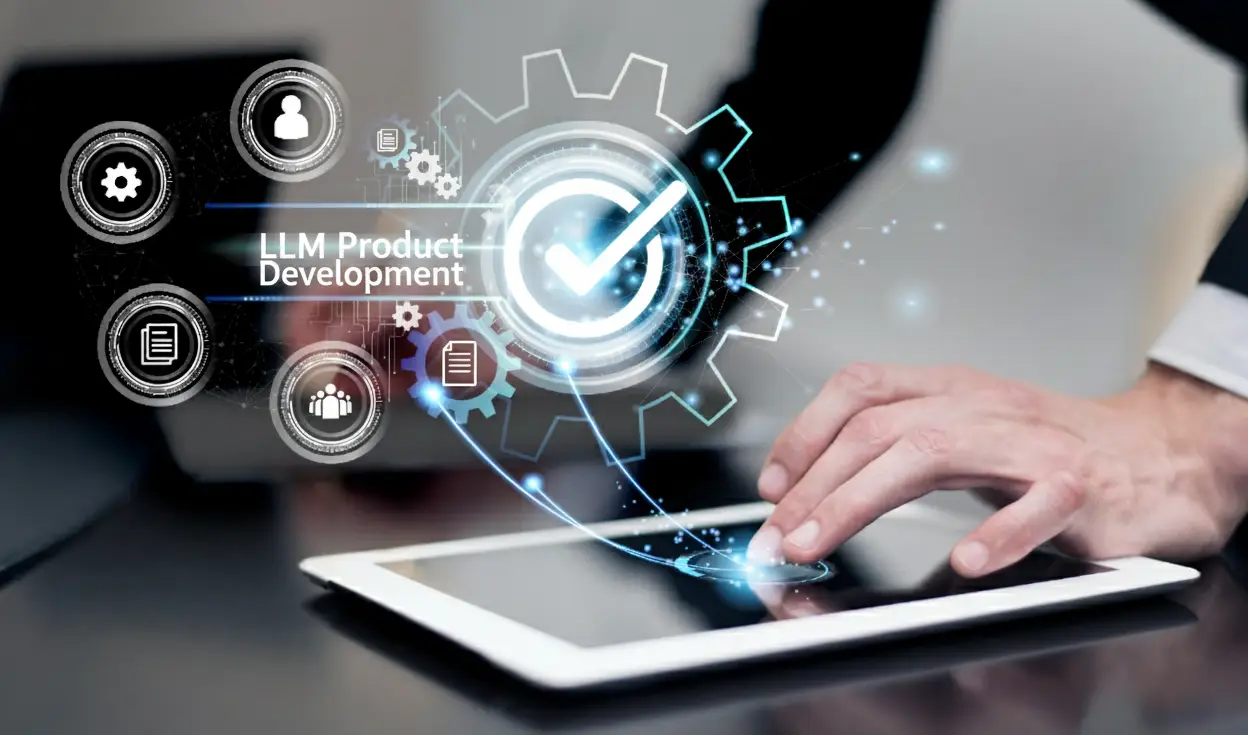
What is LLM Product Development?
LLM product development refers to the process of designing, developing, deploying, and continuously improving digital products that derive their core intelligence from large language models. These models, trained on massive datasets of text and code, possess the ability to understand context, reason through information, and generate natural language outputs that resemble human communication.
Building an LLM product requires more than plugging in a pre-trained model. It demands a holistic approach that integrates the model with data pipelines, APIs, user experience design, and governance frameworks. The goal is to transform a language model from a general-purpose engine into a domain-specific solution that creates tangible business value.
Whether it’s a chatbot that handles complex customer queries, an internal knowledge assistant for employees, or an AI copilot that augments creative and technical workflows, product development with LLMs involves aligning the technology with business strategy and user expectations.
AI alone doesn’t create impact, intelligent product design does.
Discover how Experion builds LLM-powered digital solutions
Choosing the Right Foundation Model
Selecting the appropriate foundation model is the cornerstone of successful LLM-based product development. The choice affects accuracy, cost, latency, scalability, and compliance.
- Proprietary Models : Industry-leading models such as GPT-4, Claude, and Gemini offer cutting-edge performance and reliability. They provide strong natural language understanding, support for multiple languages, and pre-configured safety guardrails. For organizations prioritizing time-to-market and quality assurance, proprietary models can be ideal starting points.
- Open-Source Models : Alternatives such as Llama, Mistral, and Falcon have gained traction for their flexibility and transparency. They allow full control over data, customization, and deployment. Enterprises in regulated sectors often prefer these models to ensure data residency and privacy compliance.
- Evaluation Criteria : When assessing a foundation model, consider:
- Performance — linguistic accuracy, reasoning, contextual comprehension
- Latency — response speed and scalability under load
- Cost — per-token pricing or infrastructure overhead
- Privacy and Control — the ability to deploy on-premises or within a secure cloud
- Multi-Model and Routing Strategies : Increasingly, LLM systems employ multiple models simultaneously, routing queries to different engines based on complexity or cost constraints. This multi-model strategy enhances reliability and efficiency.
Integrating Pre-Trained Models vs Building Custom Fine-Tuned Solutions
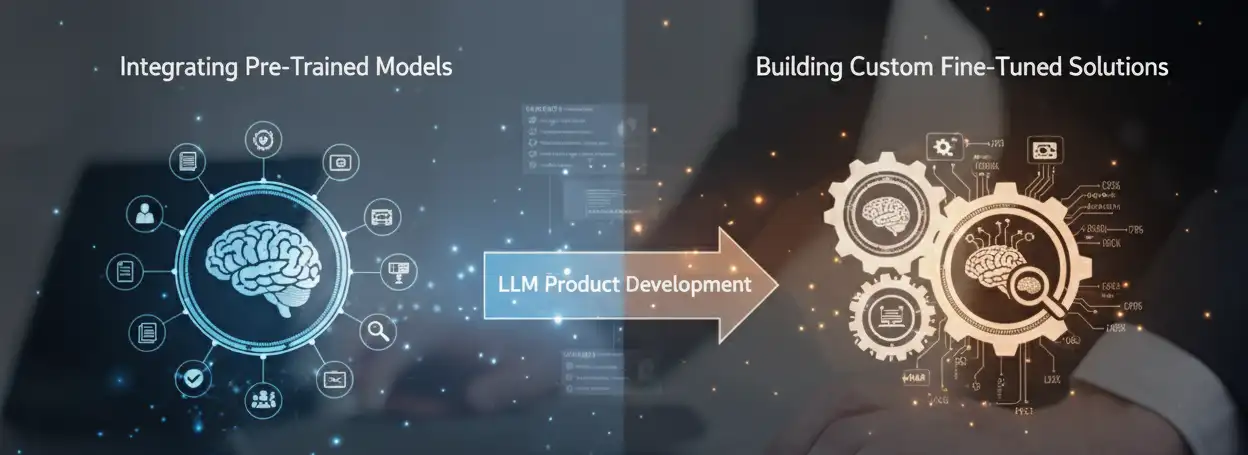
Many enterprises begin by integrating pre-trained large language models through APIs for rapid prototyping. This offers speed and simplicity but limits customization.
Fine-tuned or custom models, on the other hand, are trained on domain-specific data, such as legal texts, medical records, or company documents, to achieve higher precision. Fine-tuning improves domain alignment, tone consistency, and factual accuracy, enabling products to perform specialized tasks.
In practice, most LLM-based product development initiatives adopt a hybrid approach: start with pre-trained models for validation, then evolve into fine-tuned or retrieval-augmented architectures for production.
Reason for Product Development with LLMs
The strategic rationale behind product development with LLMs extends far beyond novelty. These models deliver tangible benefits that enhance user experience, automate operations, and expand innovation capacity.
- Natural Language Understanding for Better UX
LLMs understand human intent, enabling intuitive interfaces. They remove friction from digital experiences by allowing users to interact naturally using conversation or text instead of structured commands. - Contextual Intelligence for Personalized Automation
By analyzing context and history, LLM products adapt dynamically to user needs, providing personalized insights, recommendations, or actions. This creates a more human and meaningful interaction between users and machines. - Multimodal Expansion for Enhanced Functionality
Modern LLMs extend beyond text, they interpret images, code, and speech. This enables new categories of products like visual question-answering tools, AI copilots, and content generation platforms.
Types of LLM Products
The potential of large language models (LLMs) extends far beyond chatbots and text generation. Their ability to understand, reason, and generate contextually accurate content makes them versatile engines of innovation across industries and business functions.
LLM product development enables enterprises to infuse intelligence into every layer of their digital ecosystem, from customer interaction and analytics to automation and creative production. Below are the key categories of LLM-based products shaping the modern enterprise landscape.
Conversational AI
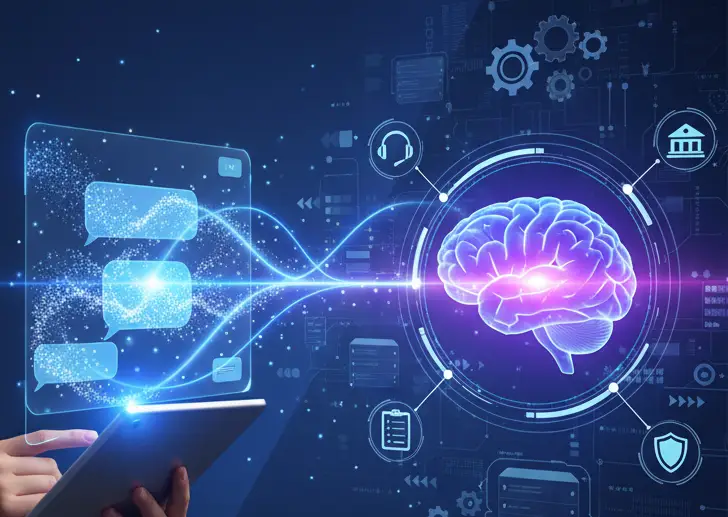
Conversational interfaces powered by LLMs represent the most recognizable and widely adopted form of AI-driven engagement. These include customer service chatbots, intelligent voice assistants, and virtual agents integrated into enterprise helpdesks.
Unlike rule-based bots, LLM systems interpret nuance, emotion, and intent, allowing fluid, natural conversations. They can answer complex queries, escalate issues intelligently, and even mirror the tone and style of human communication.
For example, an insurance company can deploy an LLM-based chatbot to guide customers through policy selection or claims processing, reducing call center workloads while improving satisfaction.
From reactive support to proactive conversation, redefine engagement with intelligent AI assistants.
Explore Experion’s LLM-Powered Conversational AI Solutions
Knowledge Assistants
Knowledge assistants are LLM-based products designed for enterprises managing vast information repositories, such as internal documentation, product manuals, and reports.
Using retrieval-augmented generation (RAG), these assistants combine generative AI with document retrieval, ensuring responses are grounded in company data. Employees can ask natural language questions like “What were our top five revenue drivers last quarter?” and receive concise, sourced answers.
For global enterprises, LLM systems like these enhance productivity, reduce information silos, and accelerate decision-making.
Workflow Automation Tools
In product development with LLMs, automation is one of the most powerful use cases. These tools interpret natural language commands and translate them into executable actions, such as generating reports, drafting emails, creating tickets, or triggering integrations with ERP systems.
For instance, an operations manager could type, “Summarize last week’s logistics delays and notify the warehouse leads,” and the LLM product would compile the relevant data, summarize findings, and automate the communication.
This represents a paradigm shift from manual workflows to AI-driven orchestration.
Data Analytics and Insights Platforms
Large language models are transforming how users interact with data. Traditional BI dashboards require technical skill to navigate, but LLM-based products allow users to query data using natural language.
A sales leader could ask, “Show me regions where revenue declined by more than 10% last quarter,” and the LLM system would parse the query, retrieve data, and visualize the result.
By democratizing access to analytics, LLMs empower non-technical users to make data-driven decisions faster, improving agility across the organization.
AI Copilots
AI copilots are among the most transformative LLM-based products today. Whether for developers, marketers, or analysts, these copilots act as intelligent collaborators, guiding users through tasks, generating suggestions, and reducing cognitive load.
In software engineering, for example, a copilot powered by LLMs can predict code completions, identify bugs, and explain complex code snippets. For marketers, it can draft campaign content, optimize SEO, or analyze engagement metrics.
These copilots represent the future of LLM product development, context-aware assistants that amplify human capability.
Content Generation Platforms
Content generation is one of the most commercially visible use cases of LLMs. From marketing and journalism to e-learning and entertainment, LLM-based products automate the creation of articles, scripts, and educational materials.
The sophistication of large language models allows for tone, style, and context adaptation, ensuring the generated content aligns with brand voice and regulatory standards.
Enterprises use these tools to accelerate production cycles and scale personalized communication without compromising quality.
Code Assistants
LLM systems are revolutionizing software development by serving as intelligent coding partners. These assistants can generate boilerplate code, debug scripts, refactor logic, and create documentation automatically.
By integrating into IDEs like VS Code or JetBrains, LLM-based products enhance developer efficiency, reduce errors, and accelerate delivery timelines.
The result is not a replacement for engineers but an augmentation, humans focusing on architecture and creativity while the LLM handles repetitive tasks.
Domain-Specific AI Applications
Industries with specialized knowledge requirements, like law, medicine, or finance, are adopting LLM-based products tailored to their needs.
For example:
- Legal firms use LLMs for contract analysis and precedent research.
- Healthcare providers deploy AI-driven assistants to summarize clinical data and aid diagnosis.
- Financial institutions rely on LLM systems for compliance automation and risk assessment.
These LLM-based applications demonstrate the versatility of product development with LLMs across regulated domains, where precision and context are paramount.
The Bigger Picture
Taken together, these categories illustrate a fundamental shift in software design. The rise of LLM product development signals the emergence of AI as a collaborator, an active, adaptive partner embedded in every workflow.
Organizations that embrace this transformation position themselves at the forefront of intelligent innovation.
LLMs aren’t just transforming products, they’re redefining how products think.
Learn How Experion Engineers AI-Driven Product Ecosystems
The Core Stages of LLM Product Development
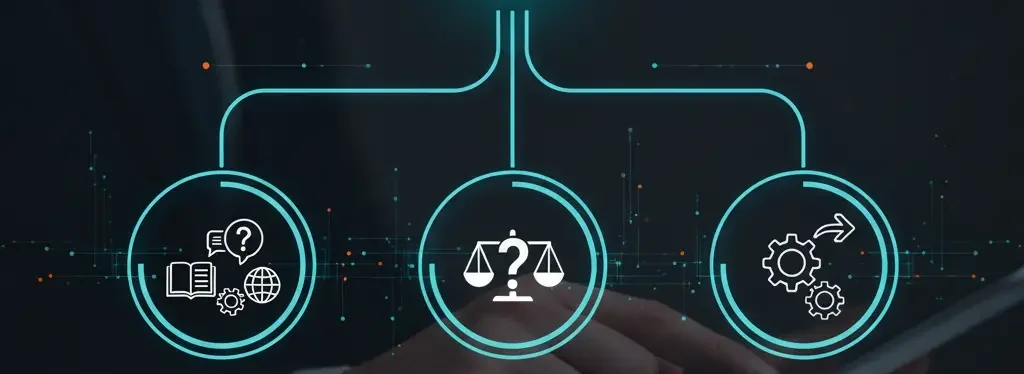
Bringing an LLM product from concept to market involves a series of deliberate, interconnected stages. These stages ensure that the final product is not only technologically sound but strategically aligned, ethical, and scalable.
Ideation and Problem Definition
Every LLM-based product development journey starts with a clear understanding of the business problem to be solved. Enterprises must look beyond hype and focus on value creation, identifying how large language models can drive measurable impact.
- Identifying Use Cases : The first step is mapping organizational pain points that can benefit from language intelligence. This might include automating customer queries, improving internal knowledge access, or streamlining workflows.For instance, a global logistics firm might explore an LLM system to automate supply chain reporting, while a university might envision a virtual tutor powered by LLMs to personalize learning experiences.
- Feasibility and Value Assessment : Not every challenge is an ideal fit for LLMs. Feasibility studies help evaluate whether the problem justifies the investment and data availability. Questions like “Is the data accessible and compliant?” or “Does an LLM outperform existing tools?” guide decision-making.
- Strategic Alignment : Finally, product goals must align with broader organizational strategy. The LLM initiative should support core objectives, whether improving customer satisfaction, reducing operational costs, or enabling new revenue streams.This stage is also where product leaders, AI teams, and business stakeholders converge to define success metrics, timelines, and governance structures.
Great AI products don’t start with code, they start with clarity.
Discover Experion’s Strategic AI Product Consulting Services
Model Selection and Data Strategy
Once the business case is established, attention shifts to the technical foundation—selecting the model and designing the data ecosystem that fuels it. The choices made here determine scalability, accuracy, and compliance in the long run.
- Model Selection : Selecting an appropriate large language model depends on several factors:
- Task Complexity: Simple classification tasks may use smaller models, while reasoning-heavy applications benefit from larger architectures like GPT-4 or Claude.
- Privacy Needs: Highly regulated industries may prefer open-source LLMs (e.g., Llama 3, Mistral) deployed on private infrastructure for maximum control.
- Cost and Latency: For cost-sensitive use cases, smaller models or model-routing strategies balance performance with budget efficiency.
Enterprises often begin with pre-trained APIs for experimentation, then migrate to customized or fine-tuned LLM systems for scale.
- Building the Data Pipeline : Data is the lifeblood of LLM product development. Building a robust pipeline involves:
- Data Collection: Aggregating high-quality, representative data from reliable sources.
- Data Cleaning: Removing inconsistencies, duplicates, and irrelevant noise.
- Labeling and Structuring: Tagging data to improve contextual understanding during fine-tuning.
- Integration with Enterprise Systems: Connecting internal knowledge bases, CRMs, and data warehouses.
Well-structured data pipelines ensure that LLM-based products deliver responses that are not only coherent but contextually grounded and trustworthy.
- Governance and Compliance : In parallel, enterprises must establish governance frameworks to manage data privacy, security, and ethical use. This includes encryption, anonymization, and audit trails for all model interactions.A strong governance layer ensures that LLM systems comply with evolving regulations like GDPR or HIPAA, safeguarding both data integrity and brand reputation.
Experion’s Data-First Philosophy
At Experion Technologies, we believe that every successful LLM product begins with a data-first strategy.
Our approach emphasizes:
- Data quality and integrity over quantity.
- Privacy and compliance baked into every data flow.
- Architecture scalability to accommodate future model evolution.
By combining deep domain expertise with proven data engineering capabilities, we ensure that each client’s LLM-based product development initiative rests on a foundation of trust, accuracy, and adaptability.
Fine-Tuning and Prompt Engineering
Fine-tuning and prompt engineering are the two most critical levers for tailoring large language models (LLMs) to enterprise needs. While pre-trained models like GPT-4, Claude, or Llama are powerful general-purpose engines, fine-tuning them transforms these models into precise, domain-specific intelligence systems.
- Fine-Tuning for Domain Precision : Fine-tuning refers to retraining an LLM on domain-specific datasets to refine its understanding of specialized language, terminologies, and contextual nuances. For example, a financial institution may fine-tune a base model on compliance documents and transaction logs, while a healthcare provider may use medical literature to improve diagnostic accuracy.This process enhances contextual relevance and factual reliability, allowing the LLM product to deliver insights that align closely with organizational expertise. Fine-tuned LLM systems can:
- Generate accurate, industry-specific responses
- Understand proprietary terms and abbreviations
- Maintain tone and compliance consistency in outputs
Fine-tuning also plays a vital role in improving LLM-based product development for regulated sectors, ensuring adherence to privacy, legal, and ethical standards.
- Prompt Engineering for Dynamic Adaptability : While fine-tuning optimizes model parameters, prompt engineering focuses on guiding model behavior dynamically, without retraining. It involves crafting inputs (prompts) that influence the LLM’s reasoning, tone, and structure of responses.Well-designed prompts can dramatically enhance performance by clarifying intent and providing examples within the query. For instance:“Summarize the customer feedback with focus on negative sentiment and suggestions.”
is far more effective than simply asking “Summarize the feedback.”Advanced prompt engineering techniques include:- Few-shot prompting: Providing examples within the prompt to establish context
- Chain-of-thought prompting: Encouraging the model to reason step-by-step
- Context window optimization: Feeding the most relevant prior interactions for continuity
This balance between fine-tuning and prompt design allows product development with LLMs to remain flexible, cost-effective, and adaptive to real-world demands.
- Continuous Learning Through Human Feedback : To further refine performance, Reinforcement Learning from Human Feedback (RLHF) is employed. Human evaluators score model responses, and this feedback is used to guide future generations of the model. Over time, this process enables continuous improvement, reducing bias and increasing alignment with enterprise objectives.Together, fine-tuning, prompt engineering, and RLHF ensure that LLM systems remain responsive, reliable, and aligned with both user expectations and business goals.
A model that learns continuously delivers value continuously.
Discover Experion’s Expertise in LLM Training and Optimization
Architecture and Integration
A robust architecture is the backbone of successful LLM-based product development. As enterprises scale from prototypes to production environments, architectural decisions determine how efficiently models perform, how secure they remain, and how easily they can evolve.
- Designing Scalable, Modular Systems : Modern LLM products require an architecture that is modular, fault-tolerant, and scalable.
- Microservices architecture : allows each AI component (data ingestion, model inference, monitoring, etc.) to evolve independently.
- APIs : serve as connective tissue, enabling seamless integration between the model, databases, user interfaces, and third-party systems.
This modularity ensures rapid iteration and easier maintenance as LLM systems mature over time. - Vector Databases and Retrieval-Augmented Generation : Enterprises increasingly combine large language models with vector databases, such as Pinecone, Weaviate, or FAISS, to store and retrieve contextual embeddings. This technique, known as Retrieval-Augmented Generation (RAG), grounds model outputs in trusted enterprise data sources.Instead of generating responses purely from training data, the model references internal documentation, knowledge bases, or policies, significantly reducing hallucinations and improving factual accuracy.
- Cloud, Hybrid, and On-Premise Deployments : Choosing the right deployment strategy depends on compliance, performance, and cost considerations:
- Cloud deployments offer agility and scalability, ideal for rapid experimentation.
- Hybrid models combine the cloud’s flexibility with on-prem security for sensitive workloads.
- On-premise setups are preferred in industries with strict regulatory constraints.
Leading cloud-native platforms, including AWS Bedrock, Azure OpenAI, and Google Vertex AI, enable managed deployment of LLMs, offering elasticity, governance, and observability.
Testing, Evaluation, and Optimization
Testing and validation are critical steps in transforming a promising LLM prototype into a reliable enterprise product. Without rigorous evaluation, even the most sophisticated model can produce unpredictable results.
- Performance and Reliability Testing : Every LLM product must undergo thorough benchmarking across dimensions such as accuracy, latency, interpretability, and scalability. Enterprises measure:
- Accuracy: How well outputs align with expected responses
- Latency: How fast the model responds under varying load conditions
- Interpretability: Whether responses can be traced or explained to end-users
Consistency across these metrics ensures the LLM system performs reliably in production environments.
- Bias, Safety, and Ethical Evaluation : Large language models are susceptible to biases inherent in their training data. Testing must include structured bias detection, fairness validation, and content filtering. Safety audits evaluate whether the model inadvertently generates harmful, offensive, or non-compliant outputs.Responsible LLM product development also includes ethical guardrails such as explainability reports, human review checkpoints, and clear accountability protocols. This builds trust among both users and regulators.
- Optimization for Cost and Efficiency : Operational efficiency is crucial in product development with LLMs. Advanced optimization techniques such as quantization, model pruning, and distillation can reduce computational demands without compromising accuracy.Caching frequently used results, implementing dynamic batching, and using serverless inference layers further optimize costs.By combining engineering discipline with AI lifecycle management, enterprises can scale intelligently while maintaining predictable operational expenses.
- Continuous Evaluation and Improvement : Evaluation doesn’t stop at launch. Feedback-driven loops ensure ongoing improvements to accuracy and usability. Experiments with alternative prompts, model parameters, or retrieval strategies can drive iterative optimization.
Continuous evaluation transforms LLM development from a one-time project into an evolving capability. At Experion, we architect LLM-based systems with scalability and compliance as first-class principles, ensuring every deployment is both future-ready and secure.
Measure relentlessly. Optimize intelligently. Deliver responsibly.
See How Experion Ensures Enterprise-Grade LLM Reliability
Deployment and Monitoring
Deployment is the moment of transformation, when a concept becomes a living, intelligent product. But for LLM-based products, the real work begins after deployment.
- Automated CI/CD Pipelines for LLMs
Continuous Integration and Continuous Deployment (CI/CD) are essential for managing rapid iterations. Automated pipelines enable teams to push updates, integrate new datasets, or adjust model parameters safely without downtime.
At Experion, we design pipelines that align with MLOps best practices, ensuring governance, rollback safety, and version traceability across model updates.
- Real-Time Monitoring and Drift Detection
Once live, LLM systems must be continuously monitored for:
- Accuracy drift: Changes in performance over time due to evolving data or usage contexts.
- Bias drift: Subtle shifts in fairness or sentiment across responses.
- Operational anomalies: Latency spikes, API failures, or scaling bottlenecks.
Automated observability dashboards and alerts help teams proactively detect and mitigate these issues before they affect end-users.
- Retraining and Lifecycle Management
Data ecosystems evolve, and so must your LLM product. Scheduled retraining ensures that the model remains current, particularly in fast-moving industries such as finance or healthcare. Feedback from real-world usage fuels continuous fine-tuning, keeping performance sharp and relevant.
- Measuring ROI and User Satisfaction
Ultimately, the success of LLM-based product development lies in measurable outcomes. Enterprises should define KPIs such as customer engagement rates, resolution times, cost savings, and user satisfaction.
Analytics dashboards provide real-time visibility into how the LLM system impacts business metrics, turning AI performance into quantifiable business value.
Experion’s Continuous Support Model
At Experion Technologies, our work doesn’t end at deployment. We offer LLM monitoring frameworks, retraining pipelines, and compliance audits that ensure long-term model stability, transparency, and ethical alignment.
By combining deep AI engineering with enterprise-grade DevOps, we help clients operationalize LLMs safely and sustainably.
These four stages, fine-tuning, architectural design, testing, and deployment, define the technical core of LLM-based product development. Together, they ensure that products powered by large language models are not just functional, but reliable, compliant, and aligned with business goals.
With the right expertise, tooling, and governance, LLM product development becomes more than a technology investment, it becomes a pathway to continuous innovation.
Your model’s lifecycle begins at launch, not ends there.
Talk to Experion About Operationalizing LLM Systems at Scale
Challenges in LLM-Based Product Development
Building scalable, enterprise-ready LLM based products goes far beyond training a large language model. It requires balancing innovation with responsibility, speed with reliability, and intelligence with ethics. As organizations accelerate their LLM product development journey, several challenges emerge that must be addressed strategically:
- High Computational and Operational Costs:
Training and fine-tuning large language models (LLMs) demand significant processing power and cloud infrastructure. The financial and environmental costs of maintaining these models at scale can quickly become prohibitive without optimization and MLOps automation. - Data Privacy and Ethical Implications:
As LLM systems rely on vast datasets, ensuring compliance with privacy laws (such as GDPR and HIPAA) is critical. Ethical concerns, including data ownership, consent, and responsible AI usage, must be addressed through robust governance frameworks. - Maintaining Contextual Relevance and Accuracy:
One of the biggest challenges in product development with LLMs is maintaining accuracy across diverse contexts. Without proper fine-tuning and feedback loops, models may generate contextually irrelevant or misleading information. - Scaling Infrastructure for Enterprise-Grade Performance:
Deploying LLM based products across global enterprise environments requires elastic infrastructure, distributed processing, and latency optimization. Achieving this balance is vital for consistent, high-performance results. - Managing Model Hallucination and Bias:
Even the best LLMs can occasionally “hallucinate”, generating confident but inaccurate responses. In sensitive industries like healthcare or finance, this can have serious consequences. Continuous monitoring, human validation, and ethical AI frameworks are essential to minimize these risks.
These challenges underscore why LLM product development is not just a technical endeavor, but a multidisciplinary process requiring collaboration, governance, and continuous learning.
Best Practices for Successful LLM Systems
Enterprises aiming to build reliable, secure, and scalable LLM systems must combine innovation with accountability. The following best practices form the foundation of sustainable LLM based product development:
- Adopt a Human-in-the-Loop Approach:
Combining human expertise with machine intelligence ensures better accuracy, contextual understanding, and ethical oversight, especially in decision-critical domains. - Focus on Explainability and Transparency:
As large language models become embedded in products, explainable AI is essential. Users and regulators need visibility into how outputs are generated and validated. - Use Modular Architecture:
Designing LLM products with modular frameworks allows for faster updates, easy fine-tuning, and seamless integration with other enterprise systems. - Invest in Continuous Learning and MLOps Integration:
Incorporating feedback loops and automated pipelines enables ongoing improvement in LLM systems, keeping them relevant as data and user needs evolve. - Collaborate Across Disciplines Early:
Effective product development with LLMs requires tight collaboration between AI engineers, domain experts, and UX designers from the outset. This ensures the system is not only intelligent but also intuitive and user-centric.
These practices elevate LLM product development from experimental to enterprise-grade, blending performance, compliance, and innovation into one cohesive framework.
Use Cases Across Industries
LLM based products are reshaping industries by bringing intelligence, automation, and personalization into core operations. Here’s how enterprises across sectors are leveraging large language models to gain a competitive edge:
- Healthcare:
LLM systems assist clinicians with decision support, automate documentation, and enhance patient interactions through conversational AI, driving efficiency and better outcomes. - Finance:
From risk analysis and fraud detection to compliance automation, LLMs help financial institutions manage complex data with speed, accuracy, and transparency. - Retail:
LLM based products enable hyper-personalized recommendations, intelligent customer service automation, and demand forecasting that adapts to real-time market signals. - Education:
Adaptive learning assistants powered by large language models personalize content delivery, assist educators, and support multilingual learning experiences. - Manufacturing:
Intelligent chatbots and knowledge documentation tools streamline operations, while predictive maintenance systems use LLMs to forecast failures and minimize downtime.
As industries embrace LLM product development, the focus is shifting from experimentation to real-world impact, driving productivity, innovation, and customer engagement at scale.
The Future of LLM Product Development
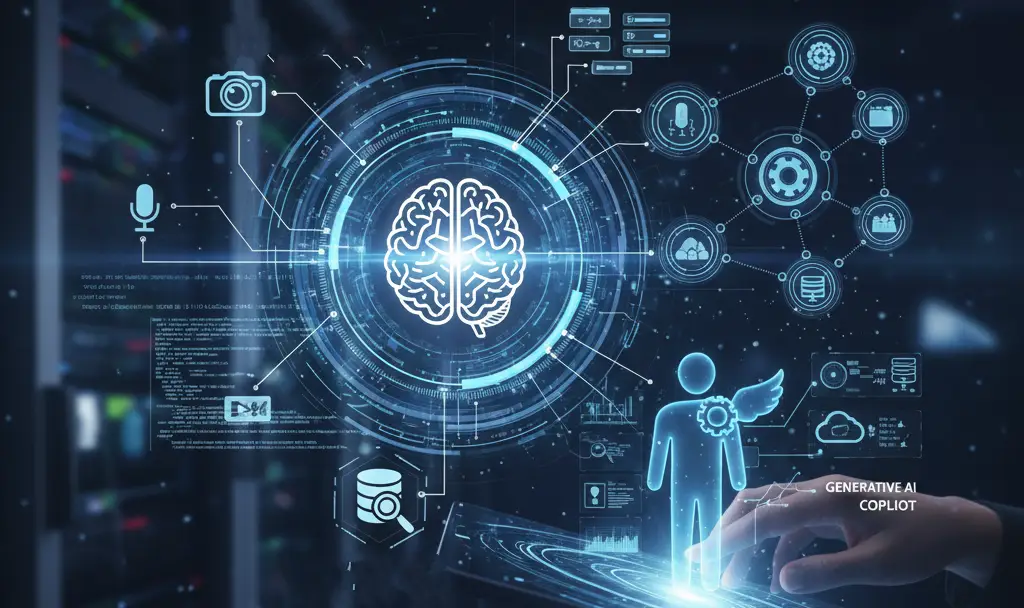
- Multimodal Models: LLMs that understand images, video, audio plus text
- Retrieval-Augmented Generation (RAG) & hybrid memory systems for grounding outputs
- Agentic AI systems: chains of autonomous agents collaborating
- Democratization via low-code / no-code LLM tooling
- Generative AI copilots becoming central in enterprise ecosystems
The future of LLM product development is about building intelligent ecosystems, not just isolated models.
How Businesses Can Get Started?
- Start with a small, high-impact MVP
- Define clear metrics for success (accuracy, cost, user satisfaction)
- Partner with an experienced AI product engineering team (like Experion)
- Build foundation models or choose open / proprietary models carefully
- Focus on data strategy, governance, and feedback loops early
From prototype to production, make your LLM journey a value-first path.
Explore Experion’s LLM Product Services
Conclusion
LLM product development is ushering in a new era of intelligent, language-first applications. By leveraging large language models, organizations can build llm based products that understand users, generate insight, and reinvent engagement.
However, success requires more than just models, it requires careful product design, architecture, governance, and continuous evolution. The most successful LLM products are those that integrate feedback, ensure safety, and deliver consistent value.
At Experion Technologies, we help enterprises transform ideas into robust LLM systems, delivering innovation that scales across domains.
Key Takeaways
- LLM product development redefines how products interact, reason, and learn
- Choosing the right foundation model (open or proprietary) is foundational
- Core stages span ideation, data strategy, tuning, architecture, deployment, and monitoring
- Challenges include cost, privacy, drift, hallucinations, and scaling
- Best practices emphasize human oversight, modular design, continuous learning
- Tools like LangChain, Vertex AI, and MLOps stacks accelerate development
The future includes multimodal systems, agentic AI, and low-code LLM democratization
At Experion Technologies, we partner with clients to build safe, scalable, and value-driven LLM product engineering solutions.

